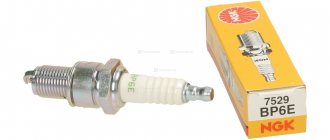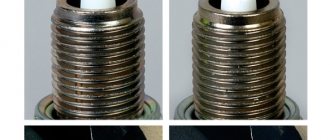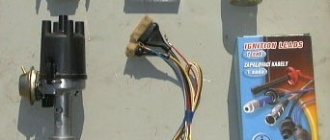02/09/2021 1,660 VAZ
Author: Ivan Baranov
The ignition system of any car, including domestic VAZs, consists of many mechanisms and components. They all work to ensure normal engine starting and optimal performance in the future. If one of the SZ components fails, this can lead to difficulty starting the motor or the impossibility of starting it altogether. What role does the VAZ ignition coil play and what elements does the system as a whole consist of? Read below.
[Hide]
Operating principle of the ignition system
The VAZ ignition system is used to ensure ignition of the air-fuel mixture to start the engine. If the VAZ ignition does not work correctly, then most likely the car owner will face the problem of poor engine starting. To prevent this, all elements of the safety system must always be in working order.
The VAZ ignition circuit, in particular, the principle of its operation is as follows:
- the first stage is the accumulation of the charge necessary to start the internal combustion engine;
- the second stage is the conversion of this charge into high-voltage voltage;
- charge distribution along the wires;
- spark formation in spark plugs;
- ignition of a flammable mixture (video author - Mikhail Nesterov).
At each of these stages, the precise operation of all components and mechanisms is important. To ensure optimal operation of the VAZ engine and its cylinders, you need to pay attention to system diagnostics from time to time.
At different positions of the regular or flip key in the lock, different processes occur in the on-board network:
- When the conventional ignition switch is positioned at mark I, the ignition switch on the VAZ actually starts working. This position is fixed; the instrument panel, optics and side lighting, as well as other equipment, operate in it.
- In position II, the device supplies voltage to the starter, which is necessary to start the internal combustion engine. This position is not fixed as the driver moves the switch key into it to start. When the motor starts running, the key should return under the action of the spring.
- III - this position is a parking position, in which all equipment does not work, and the steering column is locked with a latch.
Firing order
Wiring diagram for the VAZ ignition switch
An equally important nuance is the ignition order. Every car owner should know the ignition procedure so that in the event of a malfunction of the power unit, he can take action to repair or diagnose it. In classic VAZ models, the ignition order is as follows: first, the spark is supplied to the first cylinder, then to the third, fourth and second.
The firing order should be marked on the breaker cover. Number 1 indicates that the wire goes to the spark plug of the first cylinder. If you look at the VAZ ignition module, you will see that there are numbers on its outputs that will help you connect the wires correctly after disconnecting. The ignition order must not be violated.
VAZ 2101 ignition diagram. VAZ 2101 ignition connections
The ignition circuit of the VAZ 2101 is quite simple and does not differ much from the circuit of other classic VAZ models.
Ignition contact diagram for VAZ 2101
Explanation of the ignition contact diagram:
- Generator.
- Egnition lock.
- Distributor.
- Distributor cam.
- Spark plug.
- Ignition coil.
- Battery.
Basic elements of SZ
Before changing and setting the SZ adjustment, let's get acquainted with its main components:
- Battery and generator unit. The first is used when starting the engine, and the second when it is running.
- Switch or lock. Its purpose is to supply voltage to the electrical network and the vehicle's power supply, as well as to the solenoid relay.
- VAZ ignition coil, used to accumulate energy and convert it into a high-voltage pulse.
- Candles. Essentially, the spark plug design is a phase insulator mounted on a metal thread, with a conductor located in the center. This conductor is an electrode.
- VAZ distributor - used to distribute a high-voltage pulse along cables that are connected to the spark plugs.
- A high-voltage cable is a wire with reliable insulation. To avoid possible interference in the radio range, the inner conductor can be made in the form of a spiral. Checking the VAZ ignition module usually begins with the diagnosis of high-voltage circuits, as well as spark plugs.
General diagram of the ignition system
Contactless (electronic) ignition of VAZ 2101. Scheme. Installation procedure
Since more and more owners of VAZ 2101 and “classics” are replacing the old ignition system with a contactless (electronic) one, it would not be a bad idea to talk about it.
Scheme of the VAZ contactless ignition system
Explanation of the scheme:
- Non-contact sensor.
- Ignition distributor sensor.
- Spark plug.
- Switch.
- Ignition coil.
- Mounting block.
- Ignition relay.
- Ignition switch.
The following equipment will be required:
- Switch. Recommended models: K563.3734, K562.3734. The device includes 2 parts: the main unit and an additional one. Additional - serves as a reserve and can take over the tasks of the main unit or Hall sensor in the event of component failure.
- Candles (it is better to use A17 DVR or any similar option).
- Ignition coil marking 27.3705 (magnetic conductor must be open).
- Ignition distribution sensor (marking distributor 38.3706).
- Wire harness.
- High-voltage silicone wires (recommended manufacturers - TESLA or CEZAR).
It is worth noting! If the wires and spark plugs in the system are good, then replacing them is not necessary.
You will need a set of tools:
- keys for spark plugs, 8, 10, 12, 13 millimeters;
- probe 0.7-0.8 millimeters;
- drilling equipment;
- strobe
Types of SZ on VAZ cars
Before checking the VAZ ignition coil, let's understand the types of SZ.
- Contact system. This type is considered one of the oldest; compared to more modern options, it has many disadvantages. As a rule, most often in such systems the circuit breaker and distributor fail. In addition, over time, the SZ contacts may burn and stick, as a result of which the operation of the power unit may be disrupted.
- Contactless ignition on a VAZ or BSZ is a more modern option made by the developers to ensure higher reliability. In this case, the design eliminates the use of a breaker; instead, a contactless sensor is used. Today, BSZ is used on many cars; quite often VAZ owners install it instead of contact SZ. In general, units of this type require virtually no monitoring, since there are no rubbing elements in such systems. The use of BSZ allows you to achieve optimal engine performance and better combustion of the air mixture.
- Electronic ignition is considered one of the most advanced options. Electronic ignition also almost completely eliminates the use of friction components. In addition, such a system is equipped with various controllers, as well as a control unit. Controllers are used so that the electronic ignition can record the operating parameters of the internal combustion engine, and this, in turn, is necessary for the timely supply of a spark. This SZ ensures the most optimal and correct operation of the power unit. But its main advantage is its efficiency (the author of the video is Roman Romanov).
Types of ignition coils
On contact systems of VAZs, a standard ignition coil of type B117 A-11 is used. It has relatively compact dimensions (88 x 156 mm with 0.8 kg weight). Temperature range acceptable for operation: from -40° C to +85° C. The resistance value on the primary winding is 3.07...3.5 Ohms, on the secondary winding - 6300...9200 Ohms.
On VAZ 2106 cars of later years of production, an oil-filled ignition coil type 027.3705 is installed. It has long established itself as an imperishable classic. Its characteristics:
Operating temperature: from -40° C to +85° C;
Resistance value:
primary winding (0.45+0.05) Ohm;
secondary winding (5+0.5) kOhm;
Supply voltage 12 V.
Ignition Tuning Guide
Adjusting the VAZ ignition is a priority for many of our compatriots. Before setting the VAZ ignition, you need to check the functionality of the spark plugs and wires. Otherwise, if these elements are not working, you will waste time on adjustments, but you will not achieve the desired result.
So, how to do it right:
- First, unscrew the spark plug and close its hole with your finger or rubber plug. Using a special wrench, rotate the crankshaft until the plug flies out of the hole. If you insert your finger, you will feel the air flow pushing it out.
- The crankshaft must be turned until the mark on its pulley is positioned opposite the mark on the timing cover. After this, you can dismantle the distributor cover. At the same time, make sure that the contact of the timing gear rotor is directed towards cylinder 1.
- Unscrew the nut that secures the distributor and turn it upward. The rotor axis should be set parallel to the axis of the power unit. After this, the nut must be tightened.
- Now, using a control light, connect one of its wires to the coil, namely to its low-voltage contact, and connect the second wire to ground, that is, the car body.
- Turn the key in the lock. The distributor must be turned clockwise until the light goes out. If the lamp is not lit at all, then the system does not need adjustment.
- When the lamp goes out, the breaker should be rotated in the opposite direction. When the lamp lights up again, the device must be fixed in place by tightening the nut.
1. Turn the crankshaft with a wrench.
2. Align the marks on the pulley.
VAZ2107 fuse and relay diagram
The electrical wiring of the machine is protected by fuses, which are mainly installed in the central and additional units, located at the bottom of the instrument panel on the left side next to the steering column. The circuit from the battery to the terminals and connections is closed when the car ignition is turned on.
Owners of 2106 should be aware that the old design of fuses has long become obsolete, since each time they operate they overheat, which affects the density of the cells. Lack of tight contact between the fuse and the connectors leads to their burning. Therefore, replacement of the fuse blocks is necessary. To avoid unnecessary problems with the electrical wiring, you should inspect the safety devices every six months. If the contact part burns, it is necessary to replace the fuses and clean the sockets. Today, many VAZ 2106 owners are modernizing classic blocks, replacing them with modern blade fuses.
↑ How to set up contact ignition on a VAZ-2107
And now let's talk about how to set up the ignition of a VAZ 2107 with a contact system.
Before proceeding directly to the setup, you need to perform several preparatory procedures. First of all, do not forget to carefully examine the condition of the system elements.
The contact group is not particularly durable - it not only wears out, but also becomes covered with soot and soot. This unit does not switch a very high voltage, but it is quite enough to generate a spark that damages the contact surface.
Device
It is no secret that the contact ignition system consists of many different elements:
- battery;
- Mechanical breaker and distributor. The first gives a low voltage current, and the second - a high voltage;
- Lock, coil and spark plugs;
- There are two types of ignition timing regulators - centrifugal and vacuum;
- High voltage wires.
Let's look at the main elements in detail:
- A breaker is a unit that provides short-term separation of the current chain in the low voltage winding. At the moment of rupture, a high voltage is formed in the secondary circuit.
- A capacitor is a part whose purpose is to prevent contacts in the breaker circuit from burning. The container is installed parallel to the contact group, which allows the product to absorb a larger amount of energy. An additional function of the capacitor is to increase the voltage on the secondary winding.
- The distributor is an element of the contact ignition system, which ensures the distribution of voltage potential to each of the cylinder spark plugs. Structurally, the device consists of a cover and a rotor. There are contacts in the upper part, and the potential from the coil is directed to the central contact, and through the side contacts to the spark plugs.
- The ignition coil is a device that converts voltage (from low to high). The part is located in the engine compartment, as are most of the elements of the contact ignition system. Structurally, the product has two windings. One is low voltage and the other is high voltage.
- Distributor - is a device in which a breaker and a distributor are located together, operating from the engine crankshaft.
- Centrifugal regulator is a unit that provides a change in the ignition timing. This parameter represents the crankshaft rotation angle at which voltage is applied to the spark plugs. To ensure complete combustion of the combustible mixture, the angle in question is set ahead of time.
Structurally, the regulator is a pair of weights that act on a plate with breaker cams placed on it. It is worth noting here that the plate moves freely, but the advance angle is set due to the position of the motor distributor.
- A vacuum-type regulator is a device that provides a change in the advance angle while adjusting the level of load on the engine (changes when you press the gas pedal). The regulator is combined with the cavity of the throttle assembly and adjusts the angle taking into account the level of vacuum.
- Spark plugs are standard ignition elements that convert energy into a spark necessary to ignite the fuel mixture in the engine cylinders. At the moment the impulse is transmitted to the spark plugs, a spark is formed, igniting the combustible mixture.
- High-voltage wires (armored wires) are an invariable element of the contact ignition system, with the help of which high voltage is transmitted along the path “coil - distributor - spark plugs”. Structurally, the product is a flexible conductor of large cross-section with one copper core and multilayer insulation.











